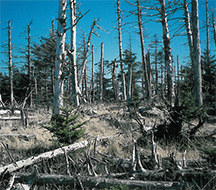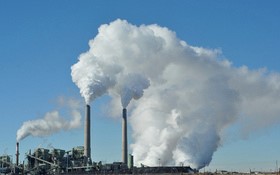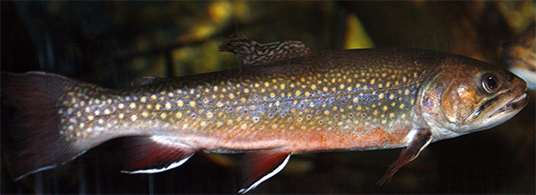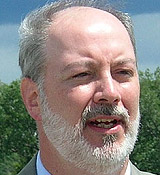
Acid Rain Reductions Should Inform Climate Change Strategy
Tuessday, December 8, 2015
By: John F. Sheehan - Adirondack Council Communications Director
This blog first appeared in the Adirondack Almanack on December 5, 2015.
 As nations engage in the Paris climate summit, we can take comfort in the fact that we have learned how to vanquish acid rain over the past 30 years and we can apply the same methods to curb global warming.
As nations engage in the Paris climate summit, we can take comfort in the fact that we have learned how to vanquish acid rain over the past 30 years and we can apply the same methods to curb global warming.
There was much to celebrate in New York when the International Acid Rain Conference: Acid Rain 2015 was held at the Riverside Convention Center in Rochester in late October. The pollutants that cause acid rain have been curbed sharply.
The amount of sulfur-based air pollution falling on New York State has been reduced by a whopping 92 percent since 1985. That was the year when New York enacted the nation’s first law to control acid rain. Nitrogen oxides have decreased by more than 70 percent over those same 30 years.
In the near future, additional cuts are expected in acid rain. The U.S. Environmental Protection Agency’s Cross-State Air Pollution Rule and the proposed Clean Power Plan will help. The cross-state rule requires reductions in sulfur and nitrogen pollution to protect public health from smog and fine particles of soot. The Clean Power Plan is aimed at reducing carbon, but the efficiencies needed to accomplish that task will reduce acid rain too.
If EPA can revive its recently suspended rules for mercury emissions, those too would bring acid rain side-benefits. Last year, the Province of Ontario stunned and thrilled New York by announcing it had stopped burning coal to create electricity.
All of this is great news for the Adirondack Park – a six-million-acre national treasure that has suffered the worst acid rain damage in the nation. Its pure waters and wilderness don’t receive the most pollution of any region, but its thin soils allowed acid rain to cause the first, and most lasting, damage here.
Prevailing winds funnel most of the Midwest’s air pollution toward the Adirondack Mountains, where it falls to earth as acid rain, snow, sleet, fog and dry particles. However, as the nation slowly transitions away from coal and other fossil fuels, even the Adirondacks are showing signs of recovery. Acid rain is finally on the decline! It’s rare that scientists and environmental advocates get to celebrate a victory like this. Most of our past meetings have focused on strategies for slowing the damage. Now, we can focus on reversing it. It was important to tell our story in Rochester to colleagues from around the world at this once-every-five-years event. Many nations are just beginning to confront acid rain.
It’s rare that scientists and environmental advocates get to celebrate a victory like this. Most of our past meetings have focused on strategies for slowing the damage. Now, we can focus on reversing it. It was important to tell our story in Rochester to colleagues from around the world at this once-every-five-years event. Many nations are just beginning to confront acid rain.
It also gave us a chance to thank colleagues from around the country who have made a huge impact along the way, including Environmental Defense Fund, Natural Resources Defense Council, American Lung Association, Citizens Campaign for the Environment, the NY State Energy Research and Development Authority, and many others. Every NY Attorney General from Robert Abrams to Eric Schneiderman has helped by pressing legal actions against polluters that won settlements and hastened regulatory action.
The U.S. federal government has been studying air pollution since the 1950s. It took 20 years or so before a popular movement began in the Adirondacks and southern Canada to stop acid rain. By necessity, New York became a leader in acid rain research, advocacy, litigation and regulation.
|
The Adirondack Council was founded in 1975 and immediately attacked acid rain as a top priority. It wasn’t easy to persuade anyone acid rain was real, especially in states whose economies depended on coal mining and cheap electricity. We needed hard data. Looking ahead, our success against acid rain will seem like a hollow victory if we allow the same plants and animals to perish due to dramatic changes in our climate. Brook trout, for example, are vulnerable to rising temperatures in rivers and streams. Some changes have already begun. Fortunately, we can apply the same methods to climate that worked to curb acid rain.
Silver Lake lies in the heart of the Silver Lake Wilderness Area. Back in the 1970s, it was considered dead. More than half of its adult fish had suffocated from gill damage caused by acid rain. Its pH remained too low to accommodate reproduction.
|
|||

 Want to keep your heritage strain brook trout fishery alive? Then an upwind pollution limit of “x” is needed to safeguard its food, habitat and reproduction. Want to protect the high-elevation forests that shelter an endangered bird? Then a pollution limit of “y” is needed upwind of the mountain tops.
Want to keep your heritage strain brook trout fishery alive? Then an upwind pollution limit of “x” is needed to safeguard its food, habitat and reproduction. Want to protect the high-elevation forests that shelter an endangered bird? Then a pollution limit of “y” is needed upwind of the mountain tops.




